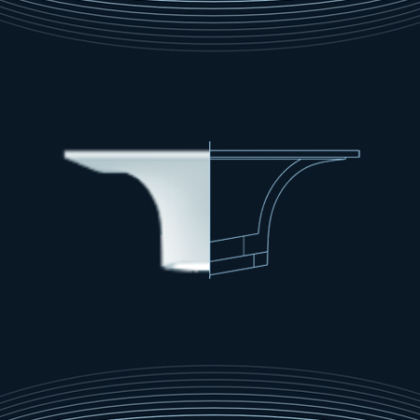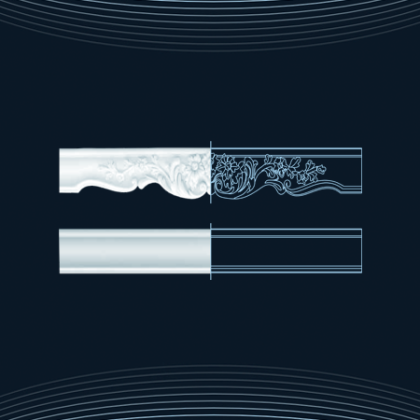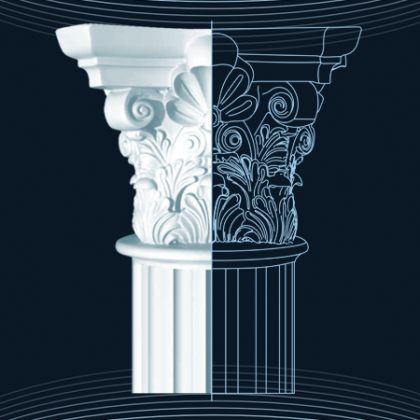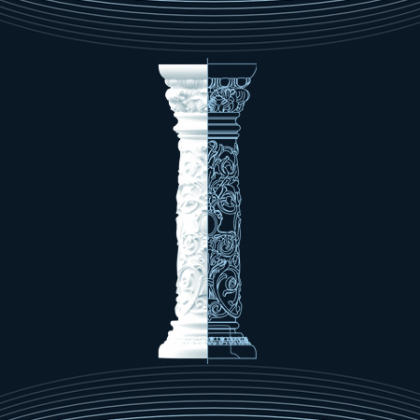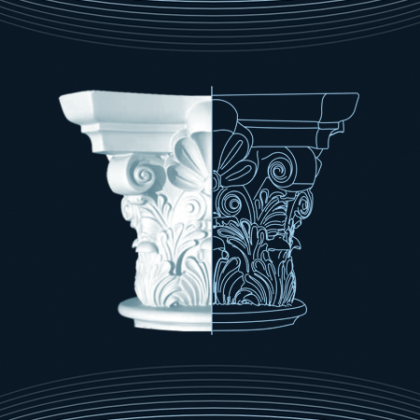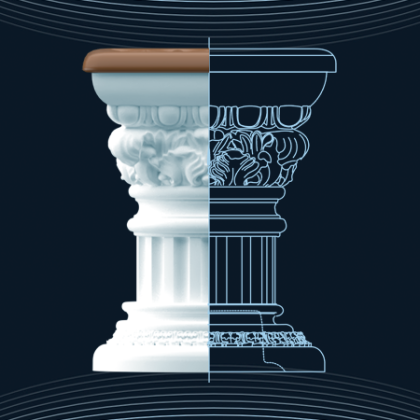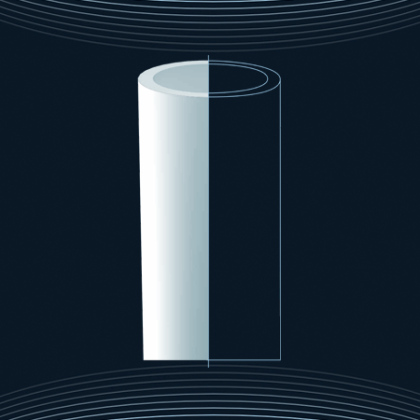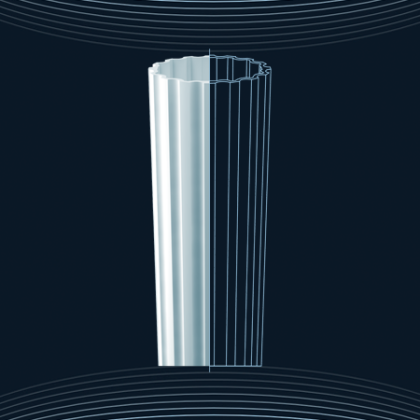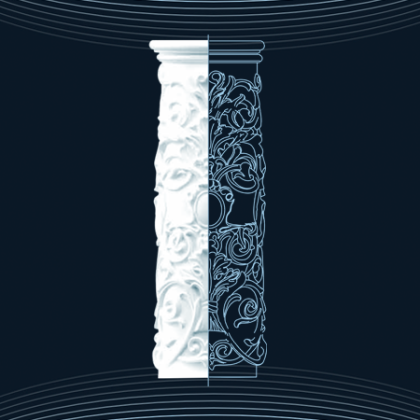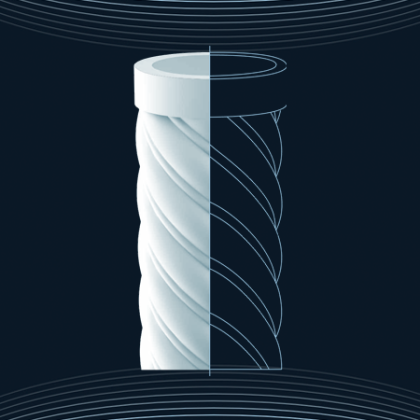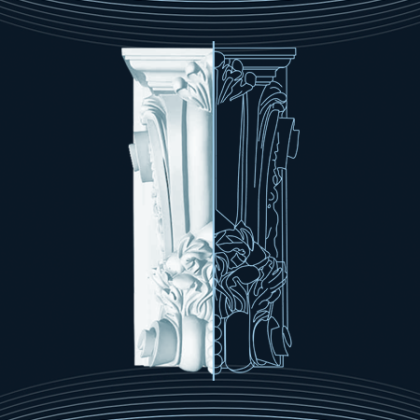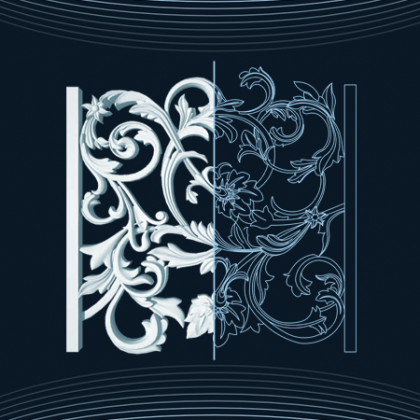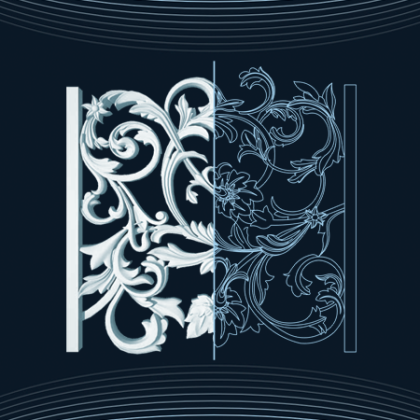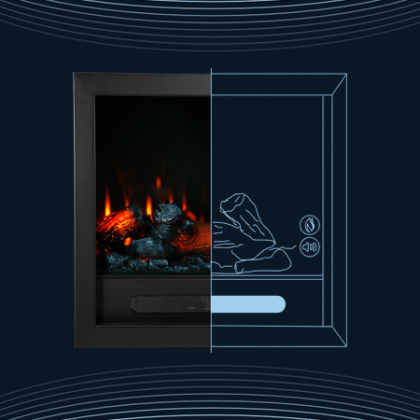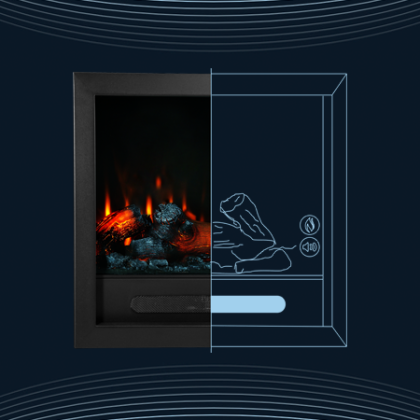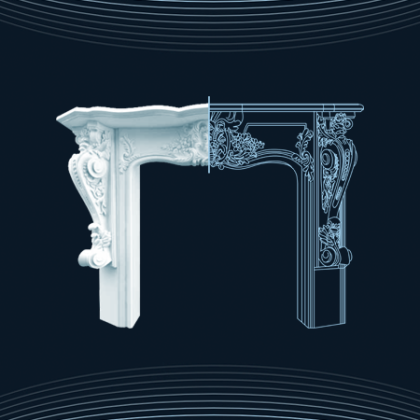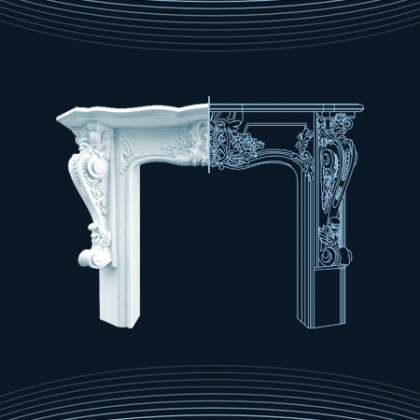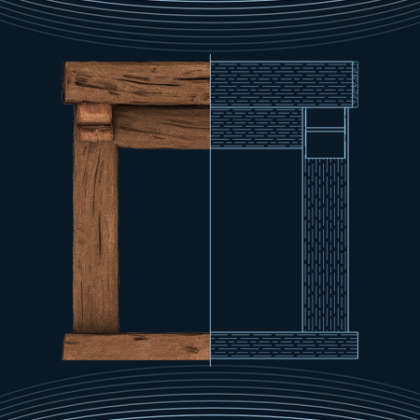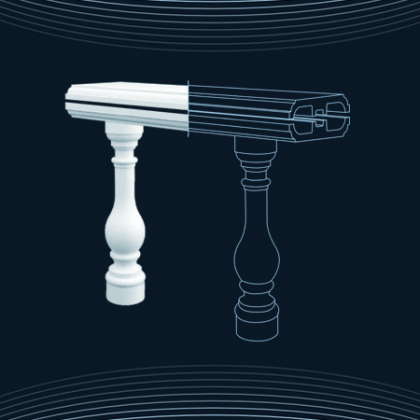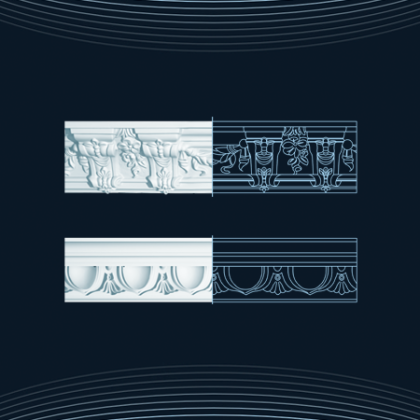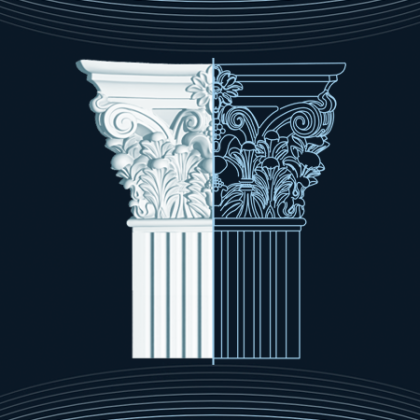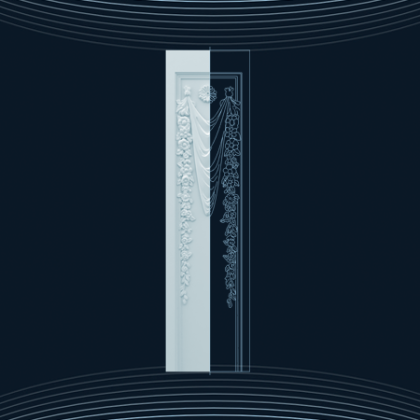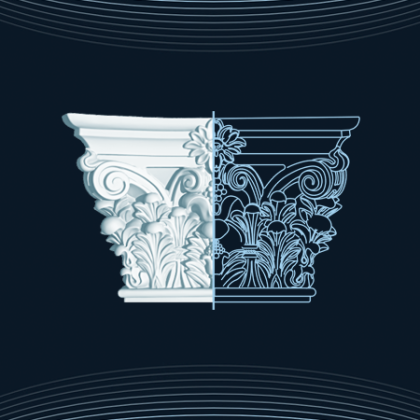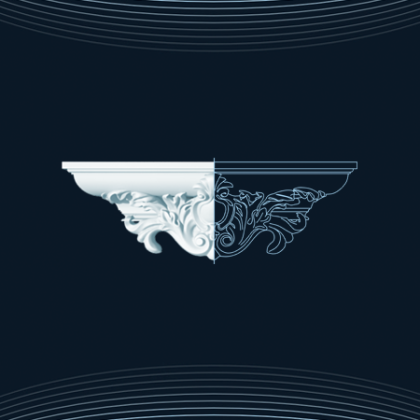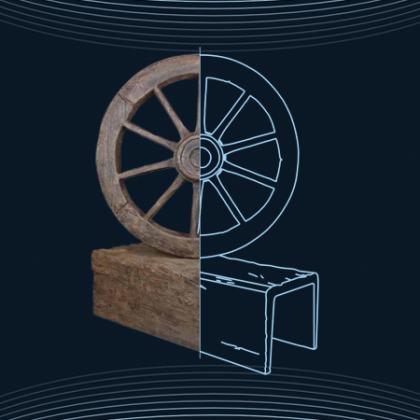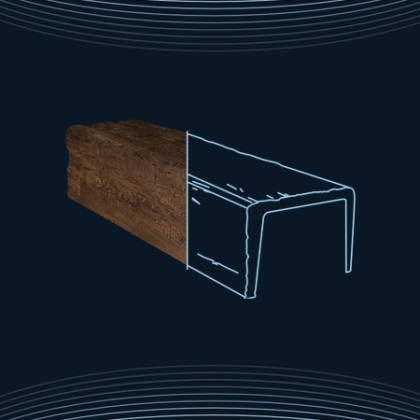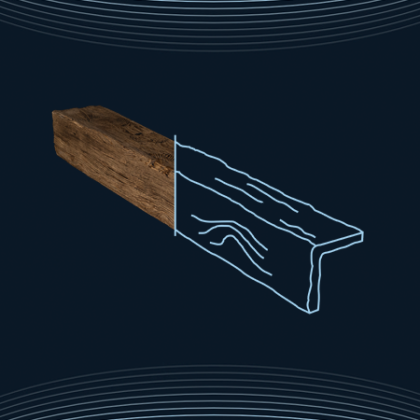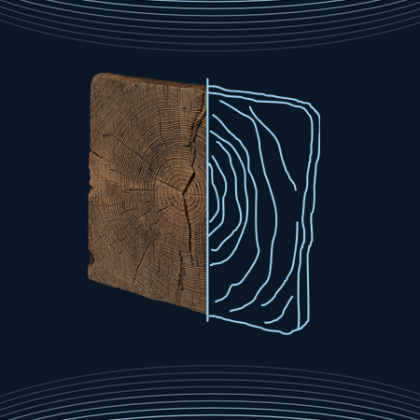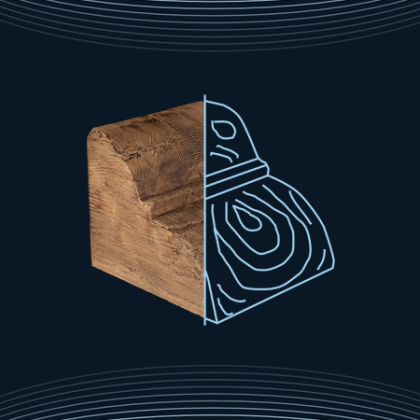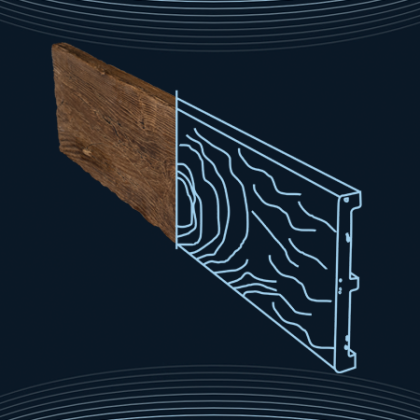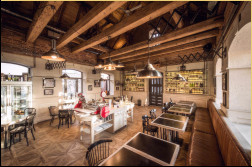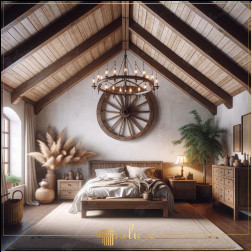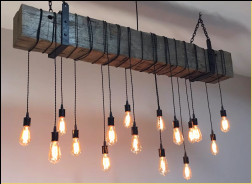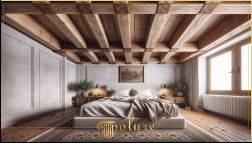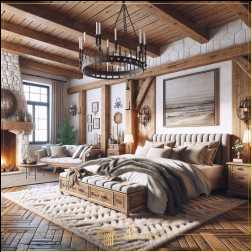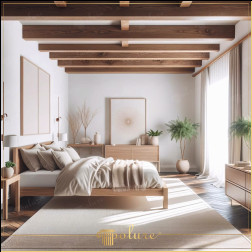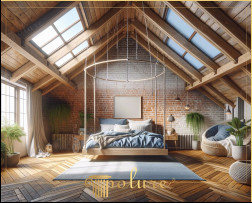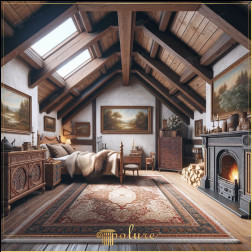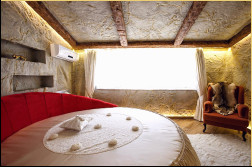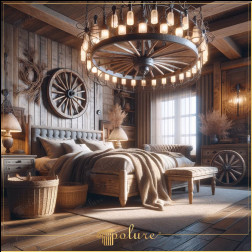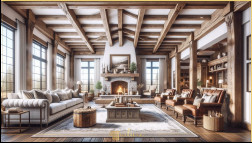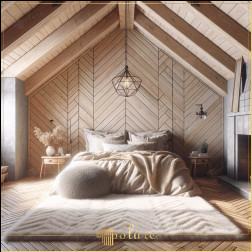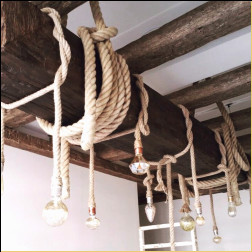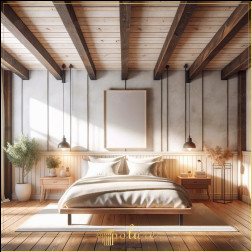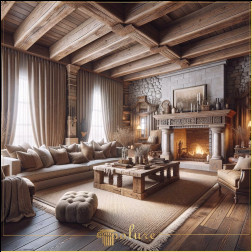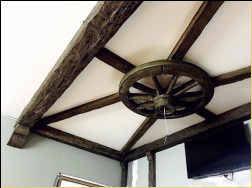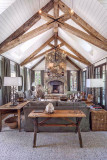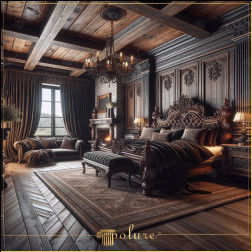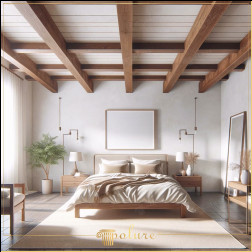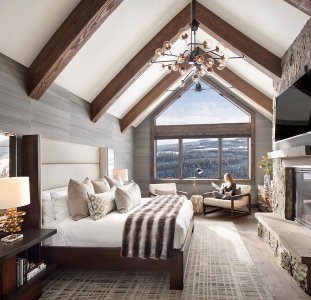
Polyurethane beam wood textured ceiling beams are decorative elements designed to look like wooden beams but are made from polyurethane, a type of plastic. These are used to add architectural interest to ceilings.
Polyurethane wood textured ceiling beams are a revolutionary architectural element that brings the aesthetic appeal of traditional wood beams with the added benefits of modern materials. These beams are crafted from high-density polyurethane, making them lightweight, durable, and resistant to wear and tear compared to their natural wood counterparts. The primary advantage of polyurethane beams is their ability to mimic the look and texture of real wood without the inherent disadvantages of wood, such as susceptibility to rot, pests, and moisture damage. This makes them an ideal choice for both residential and commercial properties looking to add a rustic or classical charm without the maintenance hassle. Installing polyurethane wood textured ceiling beams is significantly easier and less labor-intensive than installing traditional wood beams. Due to their lightweight nature, they can be easily handled and installed without the need for heavy lifting equipment or extensive structural modifications. Maintenance is minimal, requiring only regular dusting and occasional cleaning with a mild detergent to keep them looking fresh. One of the most appealing aspects of polyurethane wood textured ceiling beams is their design flexibility. They are available in a wide range of sizes, shapes, and wood grain textures, allowing for customization to fit any interior design theme. Whether you are aiming for a rustic farmhouse look, a sophisticated classical style, or a modern minimalist aesthetic, there is a polyurethane beam that can complement your space. Choosing polyurethane beams over traditional wood beams can also have a positive impact on the environment. By reducing the demand for timber, these synthetic beams help to preserve forests and reduce deforestation rates. Additionally, the longevity and durability of polyurethane materials mean less frequent replacements, contributing to reduced waste. In conclusion, polyurethane wood textured ceiling beams offer an innovative solution for those looking to incorporate the beauty and warmth of wood into their spaces without the drawbacks. With their durability, ease of installation, and environmental benefits, they are an excellent choice for any renovation or new construction project.Polyurethane Wood Textured Ceiling Beams
Benefits of Polyurethane Beams
Installation and Maintenance
Design Flexibility
Environmental Impact
Polyurethane beam wood textured ceiling beams are a modern innovation that imitates the appearance of traditional wooden beams. These synthetic beams provide the look of wood without the weight, cost, and maintenance, fitting into contemporary design and construction practices while honoring historical aesthetics.
The advent of polyurethane beam wood textured ceiling beams represents a significant milestone in the evolution of architectural materials and design techniques. While traditional solid wood beams have been used for centuries in construction for their structural support and aesthetic appeal, the development and incorporation of polyurethane beams have introduced a new era in architectural design. Polyurethane, a type of polymer, was first synthesized in the late 1930s. However, its application in creating wood-textured ceiling beams did not become widespread until much later. The innovation of polyurethane beams emerged as a response to the need for lighter, more versatile, and cost-effective materials in construction. These beams mimic the appearance of traditional wood but offer advantages in terms of durability, maintenance, and installation ease. The introduction of polyurethane beam wood textured ceiling beams has had a profound impact on architectural design. Firstly, it has made the rustic and traditional aesthetic of wooden beams accessible to a broader range of projects, including those with budgetary or structural constraints that would not typically accommodate solid wood beams. Secondly, the versatility of polyurethane allows for greater creativity in design, enabling architects and designers to explore new forms and applications that were previously impractical or impossible with solid wood. One of the most significant contributions of polyurethane beam wood textured ceiling beams to the field of architecture is their role in preservation and sustainability. By providing an alternative to solid wood, these beams reduce the demand for timber, thereby contributing to forest conservation efforts. Furthermore, their durability and low maintenance requirements offer a sustainable option that can reduce the need for replacements and repairs over time. In conclusion, the place of polyurethane beam wood textured ceiling beams in history is not just as a modern construction material but as a transformative element in architectural design and sustainability. By blending the aesthetic appeal of traditional wood with the benefits of modern technology, these beams represent a significant advancement in building materials, impacting the way buildings are designed, constructed, and preserved for future generations.The Historical Significance of Polyurethane Beam Wood Textured Ceiling Beams
Origins and Evolution
Impact on Architectural Design
Preservation and Sustainability
Conclusion
Polyurethane beams with a wood texture for ceilings have properties such as durability, light weight, and easy installation. They mimic the appearance of real wood but require less maintenance.
Polyurethane beam wood textured ceiling beams are a popular choice for homeowners and designers looking to add charm and character to their interiors. These beams mimic the appearance of real wood but are made from polyurethane, a type of plastic that is both lightweight and durable. This article explores the properties that make polyurethane wood textured ceiling beams an attractive option for residential and commercial spaces. One of the most significant advantages of polyurethane ceiling beams is their lightweight nature. Unlike traditional wood beams, which can be heavy and require substantial support structures, polyurethane beams can easily be installed without the need for extensive modifications to the existing architecture. This makes them ideal for renovation projects or installations where weight is a concern. Polyurethane is known for its durability and resistance to wear and tear. These beams are not susceptible to the common issues that affect natural wood, such as rot, termites, or warping due to moisture. This makes polyurethane beams a long-lasting addition to any space, maintaining their appearance and structural integrity over time. Advancements in manufacturing technology have allowed for polyurethane beams to closely mimic the look and feel of real wood. From the grain patterns to the color variations, these beams can be almost indistinguishable from the real thing. This allows for the creation of a warm and inviting atmosphere, with all the aesthetic benefits of wood, without the associated maintenance. The installation process for polyurethane wood textured ceiling beams is straightforward and can often be completed by the homeowner. The beams are typically mounted directly to the ceiling using adhesive and/or screws. Since they are lightweight, the process is much less labor-intensive compared to installing traditional wood beams. Another benefit of polyurethane ceiling beams is the wide range of customization options available. They can be manufactured in various sizes, shapes, and finishes, allowing for a high degree of personalization to match any design aesthetic. Whether you are aiming for a rustic, contemporary, or traditional look, there is likely a polyurethane beam option to suit your needs. While the initial cost of polyurethane beams may be higher than some traditional materials, their longevity and low maintenance requirements make them a cost-effective choice in the long run. Additionally, the ease of installation and the ability to avoid structural reinforcements can result in significant savings during the renovation process. In conclusion, polyurethane beam wood textured ceiling beams offer a unique combination of aesthetic appeal, durability, and ease of installation. Their realistic appearance and customizable nature make them a versatile option for enhancing the beauty and character of any space, while their practical benefits ensure they remain a popular choice among homeowners and designers alike.Polyurethane Beam Wood Textured Ceiling Beams Properties
Lightweight
Durability
Realistic Appearance
Easy Installation
Customization
Cost-Effective
Polyurethane beam wood textured ceiling beams are used for decoration.
Polyurethane Beam Wood Textured Ceiling Beams Decoration
Polyurethane, a versatile and durable material, has found its way into various applications, including the realm of home decoration. Among its numerous uses, polyurethane beam wood textured ceiling beams stand out for their aesthetic appeal and functional benefits. These decorative elements mimic the look of real wood, providing a rustic or traditional charm to interiors without the weight and potential for decay associated with natural wood.
Advantages of Polyurethane Ceiling Beams
Polyurethane ceiling beams offer several advantages over traditional wood beams:
- Lightweight: They are significantly lighter, making them easier to install without requiring structural modifications to the ceiling.
- Durable: Polyurethane is resistant to moisture, termites, and decay, ensuring that the beams maintain their appearance over time without the need for frequent maintenance.
- Versatile: Available in a variety of textures and colors, polyurethane beams can be designed to match any interior decor style.
- Cost-effective: They are generally more affordable than real wood beams, both in terms of material costs and installation expenses.
Applications of Polyurethane Ceiling Beams
Polyurethane ceiling beams can be used in various settings to enhance the aesthetic appeal of a space. Some common applications include:
- Residential homes: Adding warmth and character to living rooms, dining areas, and bedrooms.
- Commercial spaces: Enhancing the ambiance of restaurants, hotels, and office lobbies.
- Historic renovations: Providing an authentic look in restoration projects without the drawbacks of using actual aged wood.
Installation Considerations
While polyurethane beams are relatively easy to install, there are a few considerations to keep in mind:
- Ensure the ceiling can support the weight of the beams, despite them being lightweight.
- Measure the area accurately to order beams of the correct size and quantity.
- Consider hiring a professional installer for precise fitting and secure mounting.
In conclusion, polyurethane beam wood textured ceiling beams offer a practical and attractive solution for adding architectural interest and charm to any space. Their durability, ease of installation, and cost-effectiveness make them a popular choice for both residential and commercial decoration projects.
Polyurethane beams with wood texture for ceilings.
Polyurethane wood textured ceiling beams are an innovative and aesthetically pleasing solution for adding character and warmth to any room. Unlike traditional wooden beams, which can be heavy, susceptible to pests, and require significant maintenance, polyurethane beams offer a lightweight, durable, and maintenance-free alternative. These beams are meticulously crafted to mimic the texture, color, and appearance of real wood, making them a perfect choice for both contemporary and traditional interiors. One of the major advantages of polyurethane wood textured ceiling beams is their ease of installation. Due to their lightweight nature, they can be easily mounted on ceilings without the need for structural reinforcements, making them ideal for both new constructions and renovation projects. Furthermore, these beams are resistant to moisture, termites, and other pests that typically affect natural wood, ensuring a long-lasting and pristine appearance. Available in a variety of models and finishes, polyurethane wood textured ceiling beams can complement any room's decor. From rustic to modern designs, these beams can be customized to suit individual preferences and interior themes. They are an excellent choice for enhancing the architectural details of a space or adding a focal point to rooms with high ceilings. In conclusion, polyurethane wood textured ceiling beams provide a practical, durable, and visually appealing option for homeowners and designers looking to incorporate the beauty of wood into their spaces without the associated drawbacks. With their versatility and ease of installation, these beams are quickly becoming a preferred choice for both residential and commercial interiors.Polyurethane Wood Textured Ceiling Beams
Can polyurethane beams that look like wood be used on outside walls?
When it comes to home renovation or construction, the use of materials that offer both aesthetic appeal and durability is paramount. One such material that has gained popularity for its versatility and wood-like appearance is polyurethane. Specifically, polyurethane beam wood textured ceiling beams are often sought after for their ability to enhance the visual appeal of interiors. However, a question that frequently arises is whether these beams can be used on exterior walls. Polyurethane is known for its exceptional durability. It is resistant to weathering, wear, and tear, making it an ideal material for both indoor and outdoor use. Unlike natural wood, polyurethane does not rot, warp, or succumb to insect damage. This resilience makes polyurethane wood textured beams a viable option for exterior walls. Using polyurethane beams on exterior walls offers several advantages. Firstly, they provide the rustic charm and warmth of wood without the maintenance requirements of real wood. They are also lightweight, which makes them easy to install and reduces the load on structural supports. Additionally, their resistance to environmental factors means they will maintain their appearance over time, contributing to the property's curb appeal and value. While polyurethane beams are suitable for exterior use, proper installation is crucial to ensure their longevity. It is important to follow the manufacturer's instructions closely. Using the right type of fasteners and sealants that are specifically designed for outdoor use will help in protecting the beams from moisture and ensuring they are securely attached to the exterior walls. In conclusion, polyurethane beam wood textured ceiling beams can indeed be used on exterior walls. Their durability, resistance to environmental factors, and aesthetic appeal make them an excellent choice for enhancing the exterior of a home. With proper installation and care, these beams can provide the beauty of wood without the associated maintenance, making them a smart investment for homeowners looking to add character and value to their property.Can Polyurethane Wood Textured Ceiling Beams Be Used on Exterior Walls?
The Durability of Polyurethane Beams
Advantages of Using Polyurethane Beams on Exterior Walls
Considerations for Installation
Conclusion
Can you paint polyurethane beams that look like wood on the ceiling?
Adding decorative beams to your ceiling can dramatically enhance the aesthetic appeal of your interior space. Polyurethane beams, known for their lightweight and wood-like texture, offer an excellent alternative to heavy, real wood beams. One common question regarding these synthetic beams is whether they can be painted to match specific decor preferences. The answer is yes, polyurethane wood textured ceiling beams can indeed be painted, and doing so can further customize your home's look. Before painting your polyurethane beams, proper preparation is crucial to ensure the paint adheres well and the finish is smooth and durable. Start by cleaning the beams thoroughly to remove any dust or grease. A mild detergent mixed with water should suffice. After cleaning, lightly sand the surface with fine-grit sandpaper to create a texture that the paint can grip onto. Wipe away the sanding dust with a clean, damp cloth and allow the beams to dry completely. When selecting paint for polyurethane beams, it's important to choose a type that is compatible with plastic materials. Acrylic latex paint is a popular choice due to its durability and ease of application. For the best results, apply a primer designed for use on plastic surfaces before painting. This will help the paint adhere better and increase the longevity of the paint job. Allow the primer to dry thoroughly as per the manufacturer's instructions before proceeding with the topcoat. To achieve a professional-looking finish, use a high-quality brush or a paint sprayer. Brushes are great for detailed work, while sprayers can provide a smooth, even coat over larger areas. Apply the paint in thin, even layers, allowing each layer to dry completely before applying the next. If you're aiming for a specific texture or finish, experiment on a small, inconspicuous area of the beam before committing to the entire surface. Painting polyurethane wood textured ceiling beams is a feasible project that can enhance the visual appeal of your home. With proper preparation, the right paint, and careful application, you can achieve a beautiful, durable finish that complements your interior design. Whether you're aiming for a bold color statement or a subtle, natural wood look, painted polyurethane beams can help you achieve your desired aesthetic.Painting Polyurethane Wood Textured Ceiling Beams
Preparation for Painting
Choosing the Right Paint
Painting Techniques
Conclusion
To apply polyurethane on wood-textured ceiling beams, follow these steps: 1. Clean the beams thoroughly to remove dust and debris. 2. Sand the surface lightly if it's previously finished or rough. 3. Use a brush or cloth to apply a thin layer of polyurethane, following the wood grain. 4. Let it dry as per the product's instructions. 5. After it's dry, lightly sand the surface again for a smooth finish. 6. Apply a second coat of polyurethane for added protection. 7. Allow it to dry completely before touching or adding any decorations.
Wood textured ceiling beams add a rustic and warm charm to any room. Protecting these beams with polyurethane not only enhances their appearance but also extends their durability. This article will guide you through the steps to apply polyurethane on wood textured ceiling beams effectively. Start by ensuring the room is well-ventilated. Remove any furniture or items below the beams to avoid damage from drips. If the beams have been previously finished or are dirty, clean them thoroughly and allow them to dry. Lightly sand the surface with fine-grit sandpaper to ensure the polyurethane adheres properly. Wipe away the dust with a tack cloth or a lint-free cloth. Stir the polyurethane gently to avoid creating bubbles. Using your chosen brush, apply a thin, even coat of polyurethane along the grain of the wood. Avoid over-application to prevent drips. Allow the first coat to dry according to the manufacturer's instructions, which typically ranges from 2 to 4 hours. Once dry, lightly sand the surface with fine-grit sandpaper to ensure a smooth finish for the next coat. Wipe away the dust with a tack cloth or a lint-free cloth. Apply a second coat, and if desired, a third coat for extra durability, following the same sanding and cleaning process between coats. Allow the final coat to cure fully, which may take up to 24 hours. Applying polyurethane to wood textured ceiling beams not only preserves their beauty but also protects them from wear and tear. With the right preparation and application technique, you can achieve a professional-looking finish that enhances the overall look of your space. Remember to always follow the manufacturer's instructions for the best results.Applying Polyurethane on Wood Textured Ceiling Beams
Introduction
Materials Needed
Preparation
Application
Conclusion
Polyurethane beam wood textured ceiling beams are made from a type of plastic that looks like wood, while styrofoam polyurethane beam wood textured ceiling beams are made from a lighter, foam-based material but also designed to mimic wood.
When it comes to enhancing the aesthetic appeal of ceilings, both polyurethane and styrofoam wood textured beams are popular choices. However, despite their similar appearances, these materials have distinct characteristics, advantages, and disadvantages. Understanding these differences can help homeowners and designers make informed decisions when selecting ceiling beams. Polyurethane beams are made from a dense type of plastic that mimics the texture and grain of real wood. This material is known for its durability and resistance to wear and tear. Styrofoam beams, on the other hand, are crafted from expanded polystyrene (EPS), a lightweight, foam-like material. While styrofoam can also be shaped and painted to look like wood, it is not as robust as polyurethane. Polyurethane beams excel in terms of durability and longevity. They are resistant to moisture, rot, and insect damage, making them suitable for both indoor and outdoor use. Styrofoam beams, while sufficient for indoor applications, may not hold up as well in environments where they are exposed to the elements or physical impacts. Styrofoam beams are incredibly lightweight, making them easy to handle and install, often requiring only adhesive and minimal tools. Polyurethane beams, while still lighter than real wood, are heavier than styrofoam and may require additional support or hardware for installation. However, the extra weight contributes to their more realistic appearance and feel. Styrofoam beams are generally more cost-effective than their polyurethane counterparts. This makes them a popular choice for budget-conscious projects. Polyurethane beams, while more expensive, offer a higher quality appearance and greater durability, potentially providing better value over the long term. Both materials have environmental considerations. Polyurethane is not biodegradable, and its production involves chemicals that can be harmful if not managed properly. Styrofoam, while recyclable in some areas, can also pose environmental hazards due to its longevity in landfills and potential to release toxic substances when burned. Choosing between polyurethane and styrofoam ceiling beams depends on various factors including budget, application, and desired longevity. Polyurethane beams offer a more durable and realistic option for those willing to invest, while styrofoam beams provide a cost-effective and lightweight solution for interior decorative purposes.Difference Between Polyurethane and Styrofoam Ceiling Beams
Material Composition
Durability and Lifespan
Installation and Handling
Cost Considerations
Environmental Impact
Conclusion
The difference is between two types of ceiling beams: those made of plaster and those made of polyurethane, both designed to mimic the texture of wood.
When it comes to enhancing the aesthetic appeal of ceilings, both polyurethane beam wood textured ceiling beams and plaster polyurethane beam wood textured ceiling beams are popular choices among homeowners and interior designers. Though they may seem similar at first glance, there are several key differences that distinguish these two materials. Polyurethane Beams are made from a type of plastic that is both lightweight and durable. This material can be molded into various shapes and textures, including those that mimic the look of natural wood. Plaster Beams, on the other hand, are made by coating a lightweight core, such as a metal or foam, with a layer of plaster. This plaster can also be textured to resemble wood, but it tends to have a more rigid and solid feel compared to polyurethane. Both types of beams can be crafted to mimic the appearance of wood, but the final look and texture can vary. Polyurethane beams often have a more uniform and consistent texture, which can sometimes lack the depth and variability found in real wood. Plaster beams, however, can be sculpted and textured in a way that more closely resembles the natural irregularities and variations of wood, providing a more authentic look. One of the major advantages of polyurethane beams is their lightweight nature, making them easier to install and less likely to require structural modifications to the ceiling. Plaster beams are generally heavier and may need additional support during installation, which can increase the complexity and cost of the project. Polyurethane beams are highly durable and resistant to moisture, making them suitable for use in a variety of environments. They are also easy to clean and maintain. Plaster beams, while durable, can be more susceptible to chipping and cracking over time. They may also require more careful cleaning and maintenance to preserve their appearance. In conclusion, both polyurethane and plaster beam wood textured ceiling beams offer unique advantages and can significantly enhance the aesthetic of a space. The choice between them will depend on the specific requirements of the project, including considerations of weight, appearance, durability, and installation complexity.Differences Between Polyurethane Beam Wood Textured Ceiling Beams and Plaster Polyurethane Beam Wood Textured Ceiling Beams
Material Composition
Appearance and Texture
Installation and Weight
Durability and Maintenance
Conclusion
Polyurethane precast is made from a type of plastic that is strong and can resist wear and tear. GRC precast, which stands for Glassfibre Reinforced Concrete, is concrete that has glass fibers mixed in to make it stronger and lighter.
In the world of construction and architectural design, materials play a pivotal role in determining the sustainability, aesthetics, and durability of structures. Among the various materials used, polyurethane precast and Glassfibre Reinforced Concrete (GRC) precast are notable for their unique properties and applications. Understanding the difference between these two can help architects, engineers, and developers make informed decisions. Polyurethane precast refers to the use of polyurethane, a type of polymer, in the creation of building elements that are cast in a reusable mold or form. This material is known for its lightweight, flexibility, and high strength-to-weight ratio. Polyurethane precast elements can mimic the appearance of more traditional materials like wood, stone, or brick, while offering enhanced durability and reduced maintenance requirements. GRC precast, or Glassfibre Reinforced Concrete precast, combines fine concrete with glass fiber reinforcements. This composition results in a material that is both lighter and stronger than conventional concrete. GRC precast is highly valued for its versatility, durability, and fire-resistant properties. It is commonly used in façades, decorative panels, and architectural cladding, offering both aesthetic appeal and structural integrity. In conclusion, both polyurethane precast and GRC precast have their own set of advantages and limitations. The choice between them depends on the specific requirements of a project, including considerations of weight, durability, design flexibility, and fire resistance. By understanding these differences, professionals can select the most appropriate material for their construction and design needs.Difference Between Polyurethane Precast and GRC Precast
What is Polyurethane Precast?
What is GRC Precast?
Key Differences
Polyurethane wood-textured ceiling beam prices.
When it comes to adding character and warmth to a room, few features make as much of an impact as exposed ceiling beams. Traditionally crafted from real wood, these architectural elements can be costly and challenging to install due to their weight and the need for structural support. However, with advancements in materials technology, homeowners and designers now have access to polyurethane beams that mimic the look and texture of real wood without the same level of investment or installation difficulty. Polyurethane beams are manufactured from a dense, durable form of plastic that can be molded and textured to replicate the appearance of natural wood. These beams are lightweight, making them easier to handle and install compared to their traditional wood counterparts. They are also resistant to warping, rotting, and pests, ensuring a long-lasting aesthetic appeal with minimal maintenance. The cost of polyurethane beam wood textured ceiling beams can vary widely based on factors such as the complexity of the design, dimensions, and the manufacturer. On average, homeowners can expect to pay anywhere from $100 to $400 per beam, with custom options potentially costing more. While this represents a significant saving over real wood beams, it's important to factor in the overall quality and desired aesthetic to ensure the investment is worthwhile. Polyurethane beams offer an attractive, cost-effective alternative to traditional wood ceiling beams. With their realistic appearance, ease of installation, and durability, they provide a practical solution for homeowners looking to enhance their interiors with the charm and warmth of wood without the high cost and maintenance. As with any home improvement project, it's advisable to compare products and prices from different suppliers to find the best deal that meets your specific design needs and budget.Polyurethane Beam Wood Textured Ceiling Beams Prices
What Are Polyurethane Beams?
Benefits of Polyurethane Wood Textured Ceiling Beams
Price Considerations
Conclusion
Information Gallery
List of detailed descriptions of images in the image gallery.
 English
English
 Romanian
Romanian
